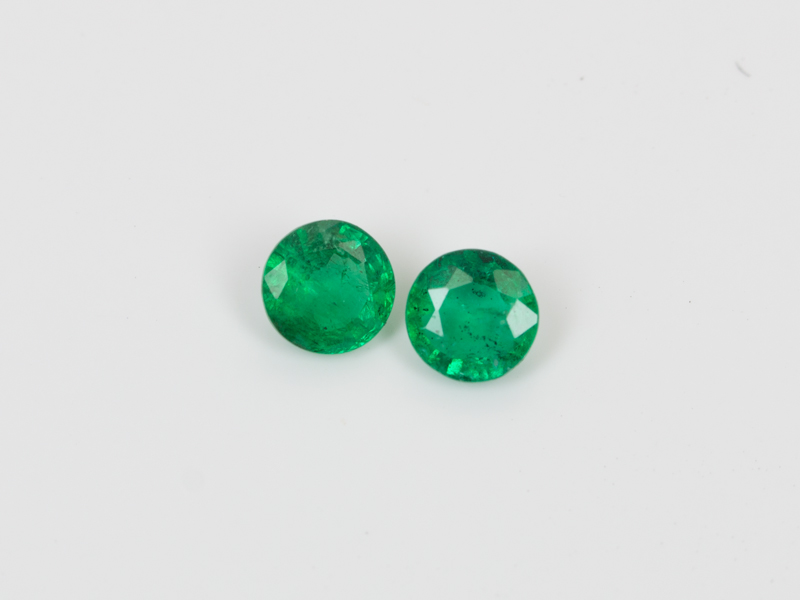All About Emeralds: Your Guide to this Lush Green Gem

Emeralds have long been associated with elegance, mystery, and a vibrant pop of color. Whether you’re drawn to their deep green hue or their rich history, these gemstones are a timeless choice for engagement rings, wedding bands, and statement jewelry. But what makes an emerald truly special? Let’s dive in!
What is an Emerald?
Emeralds are a variety of the mineral beryl, colored green by trace amounts of chromium and vanadium. Unlike diamonds, which are valued for their clarity, emeralds often contain natural inclusions, known as "jardin" (French for garden), which give each stone a unique character. Emeralds are also rarer than diamonds, making them one of the most sought-after gemstones.
Meaning of Emeralds
Throughout history, emeralds have symbolized rebirth, love, and wisdom. Ancient Egyptians, including Cleopatra, adored emeralds for their supposed healing properties and connection to fertility. Today, emeralds continue to represent harmony, new beginnings, and eternal love—making them an especially meaningful choice for bridal jewelry.
Emerald Properties
Color: Rich green to bluish-green, with deeper hues being the most valuable.
Hardness: 7.5–8 on the Mohs scale (softer than diamonds, but durable with proper care).
Clarity: Natural inclusions are common and often accepted as part of the stone’s character.
Luster: Vitreous (glassy and bright when well-cut).
Treatments: Most emeralds are treated with oils or resins to enhance clarity.

Origins of Emeralds: Where Do They Come From?
Emeralds are mined in several locations around the world, each producing stones with unique characteristics.
| Location | Characteristics |
|---|---|
| Colombia | Highly saturated green, often with excellent transparency and slight bluish tones. Considered the finest quality. |
| Zambia | Deep green with slight bluish undertones, often cleaner and more durable than Colombian emeralds. |
| Brazil | Lighter green with yellowish hues, usually larger in size but with more inclusions. |
| Ethiopia | Newer source, producing bright green emeralds with fewer inclusions. |
| Pakistan & Afghanistan |
Intense green with a mix of Colombian and Zambian traits, often smaller but high in quality. |

Price
Emerald prices vary widely based on color, clarity, and origin. Fine-quality Colombian emeralds are the most expensive, while Zambian emeralds run in the mid-range.
Tips for Choosing Emeralds
Prioritize Color: A rich, vibrant green is the top factor in an emerald’s value.
Embrace Inclusions: Unlike diamonds, inclusions in emeralds are expected and can add character.
Cut Matters: A well-cut emerald maximizes brilliance while preserving as much carat weight as possible.
Consider Origin: Colombian emeralds are top-tier, but Zambian and Brazilian stones offer beauty at a lower price.
Check for Treatments: Most emeralds are oil-treated to enhance clarity, which is normal, but avoid heavily treated stones.
Pro Tips:
- Go for an emerald with a high-quality cut and strong color saturation, even if it has some inclusions.
- The right setting—like a bezel or halo—can help protect the stone and make it shine even brighter.
Emeralds are a bold and meaningful choice for jewelry that stands out. Whether you’re choosing one for a ring or a special piece, understanding what makes them unique will help you find the perfect stone to cherish for a lifetime.
Gemstone Types
When choosing a gemstone, it’s important to understand the difference between natural and lab-grown stones. While both have their own unique appeal, your choice will depend on budget, ethics, and personal preference.
Natural Gemstones Natural gemstones are formed deep within the Earth over millions of years. They are mined from the ground and can vary in color, clarity, and inclusions due to their natural formation process.
Pros: Unique, one-of-a-kind, carries historical and natural significance.
Cons: Can be more expensive, often contain inclusions, and mining can have ethical and environmental concerns.
Currently SAMA offers only natural gemstones.
Lab-Grown Gemstones Lab-grown gemstones have the same chemical and physical properties as natural gems but are created in a controlled environment. They are not imitation stones—just gemstones grown under lab conditions rather than in the Earth.
Pros: More affordable, eco-friendly, and often have fewer inclusions.
Cons: Lack the rarity of natural stones, and some may prefer the natural origin of mined gems.
Pro Tip:
- Both natural and lab-grown gemstones are stunning choices, so it all comes down to what matters most to you—authentic rarity or ethical, budget-friendly brilliance!






